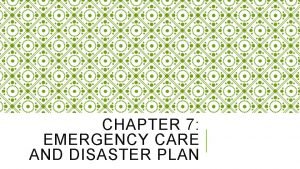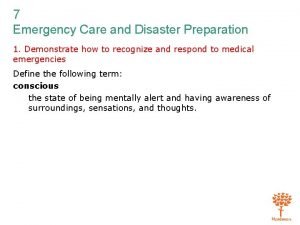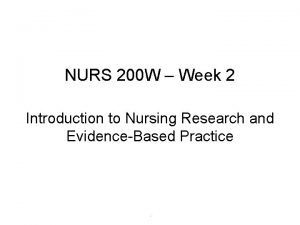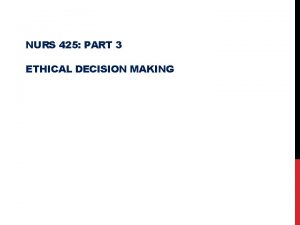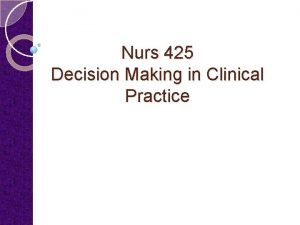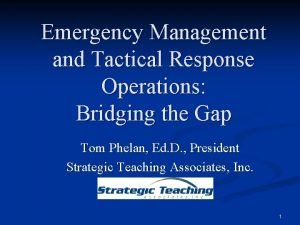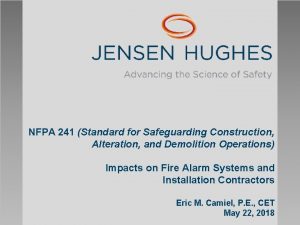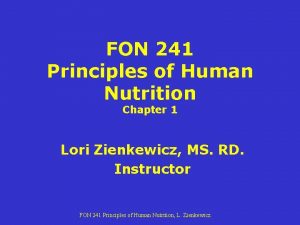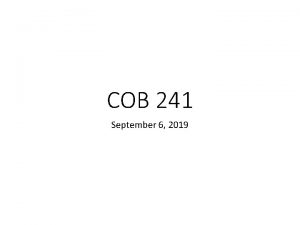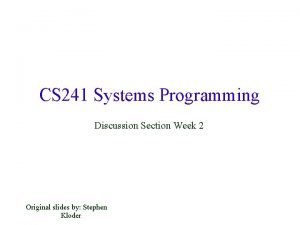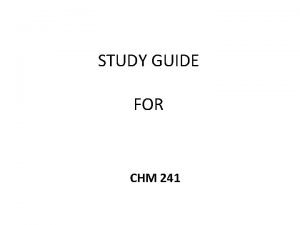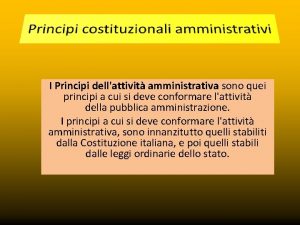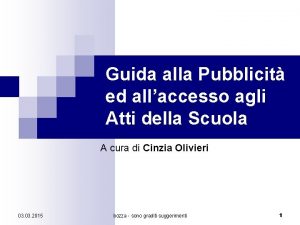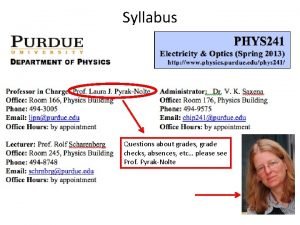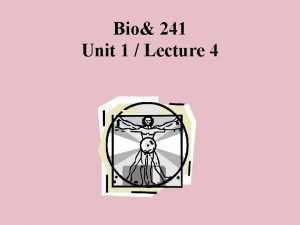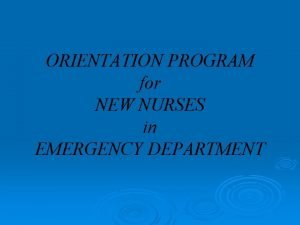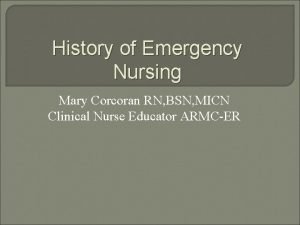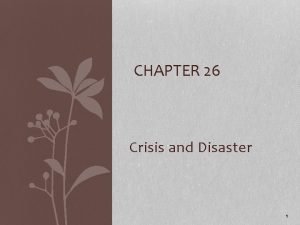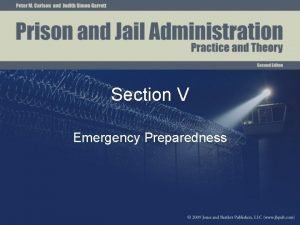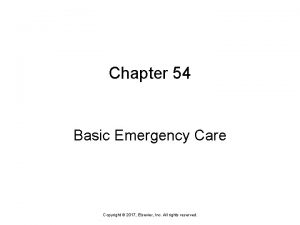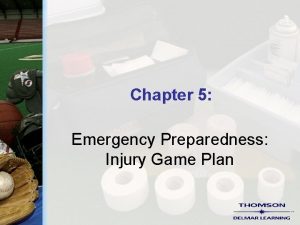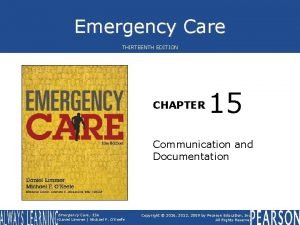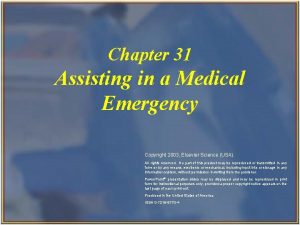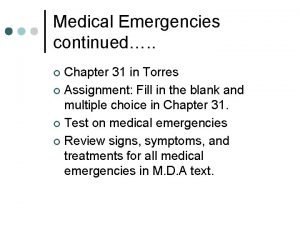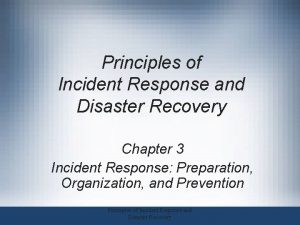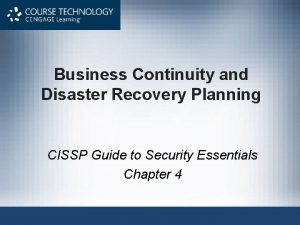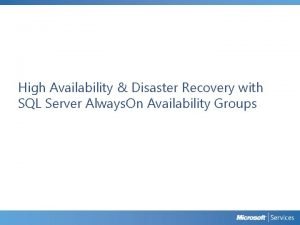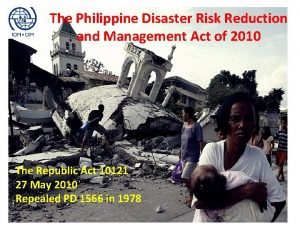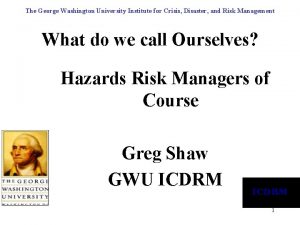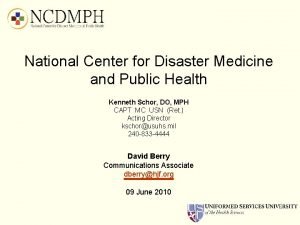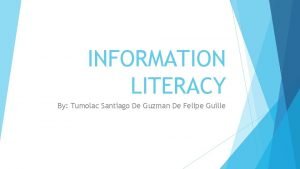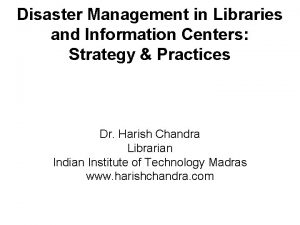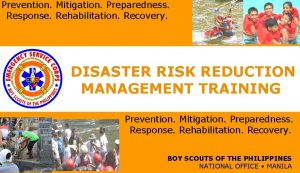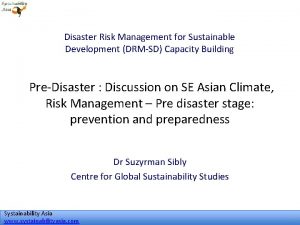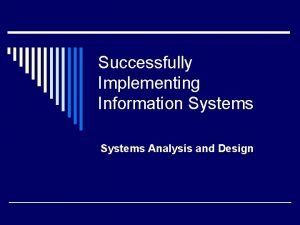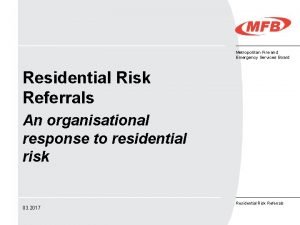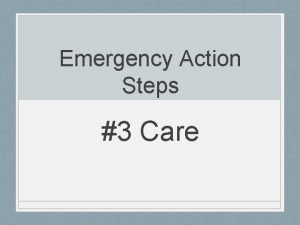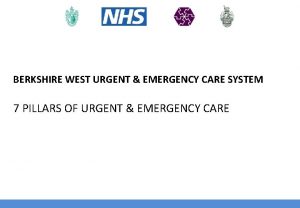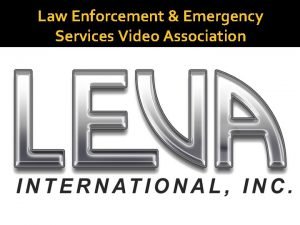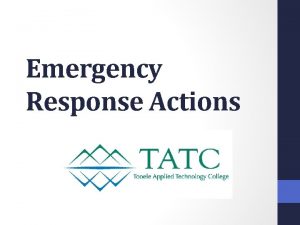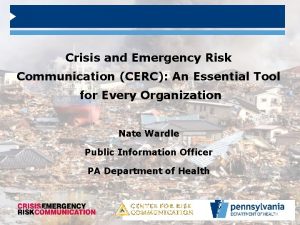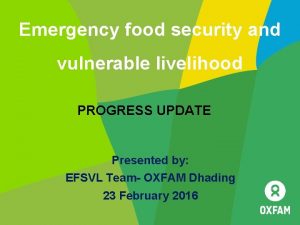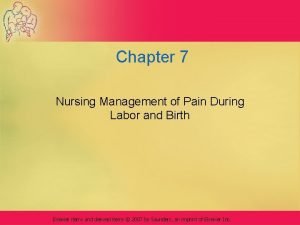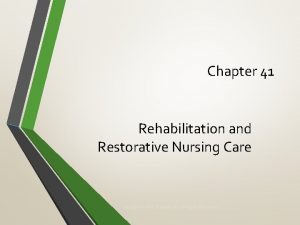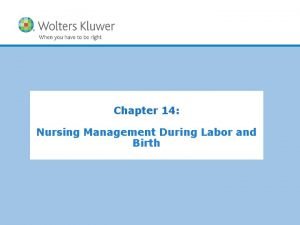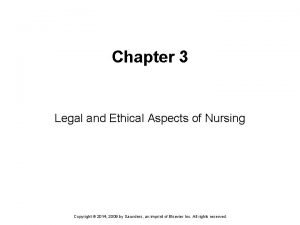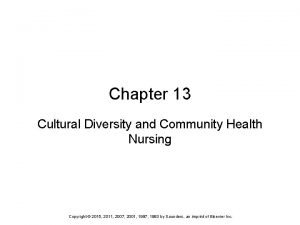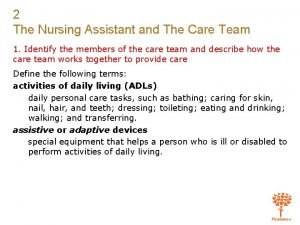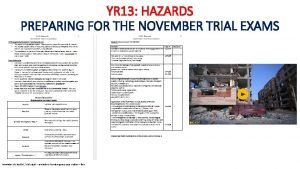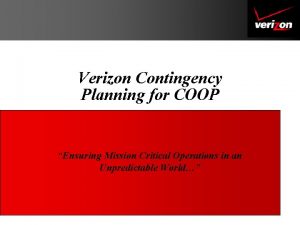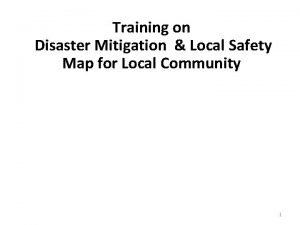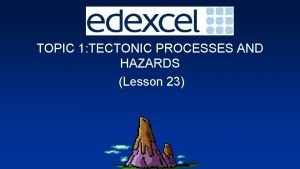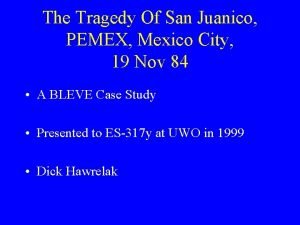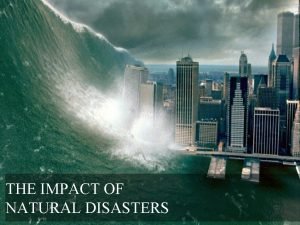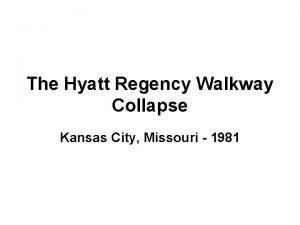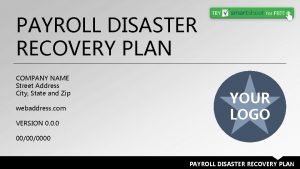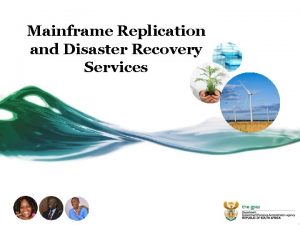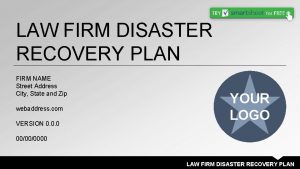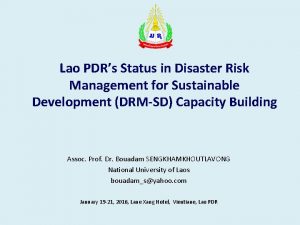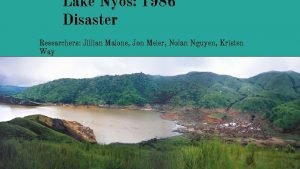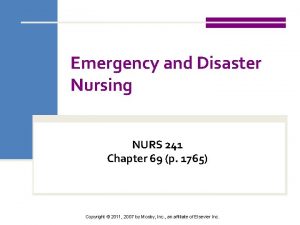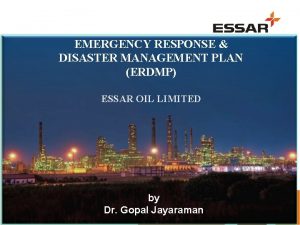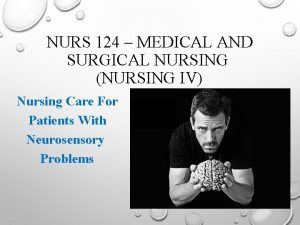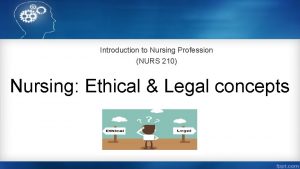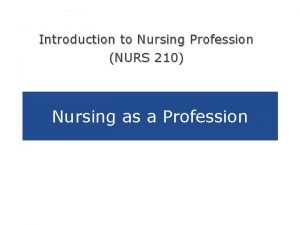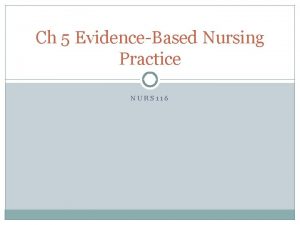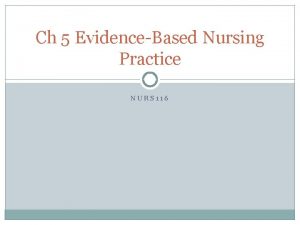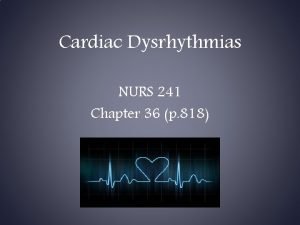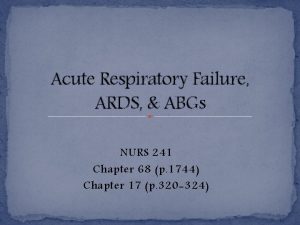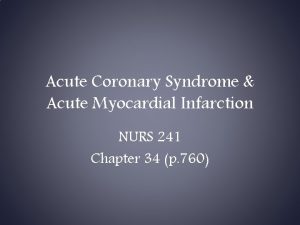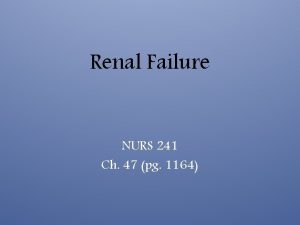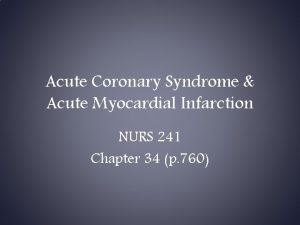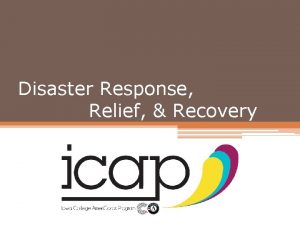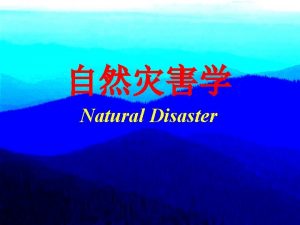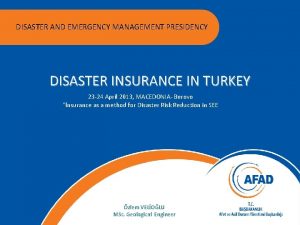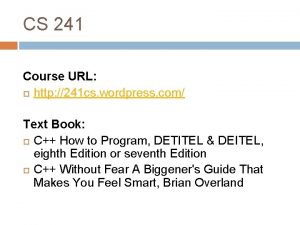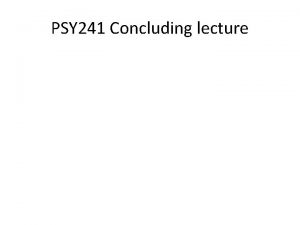Emergency and Disaster Nursing NURS 241 Chapter 69








































![Hypothermia § Mild hypothermia (93. 2º to 96. 8º F [34º to 36º C]) Hypothermia § Mild hypothermia (93. 2º to 96. 8º F [34º to 36º C])](https://slidetodoc.com/presentation_image/5d7ea788ca33236fd5be8aa93e57dfc1/image-41.jpg)
![Hypothermia § Moderate hypothermia (86º to 93. 2º F [30º to 34º C]) n Hypothermia § Moderate hypothermia (86º to 93. 2º F [30º to 34º C]) n](https://slidetodoc.com/presentation_image/5d7ea788ca33236fd5be8aa93e57dfc1/image-42.jpg)
![Hypothermia § Severe hypothermia (<86º F [30º C]) makes the person appear dead. n Hypothermia § Severe hypothermia (<86º F [30º C]) makes the person appear dead. n](https://slidetodoc.com/presentation_image/5d7ea788ca33236fd5be8aa93e57dfc1/image-43.jpg)

















































- Slides: 92

Emergency and Disaster Nursing NURS 241 Chapter 69 (p. 1765) Copyright © 2011, 2007 by Mosby, Inc. , an affiliate of Elsevier Inc.

Emergency Nursing § Triage n Process of rapidly determining patient acuity n Represents a critical assessment skill Copyright © 2011, 2007 by Mosby, Inc. , an affiliate of Elsevier Inc. 2

Emergency Nursing § Triage system: categorizes patients so most critical are treated first n Emergency Severity Index: Five-level triage system that incorporates illness severity and resource utilization Copyright © 2011, 2007 by Mosby, Inc. , an affiliate of Elsevier Inc. 3

Emergency Severity Index Triage Algorithm 4

Triage systems § Color, words or numbers sorting system § Colors: Red/emergent, yellow/urgent, Green/non-urgent § Numbers: Priority I/emergent, priority II/urgent, Priority III/non-urgent 5

Emergent § Life/limb, or eye threatening; needs immediate attention n Trauma, chest pain, cardiac arrest, severe respiratory distress, chemicals in the eyes, limb amputation, acute neurological deficits 6

Urgent § Needs treatment in 20 minutes to 2 hours n Fever > 104 F, diastolic BP > 130 mm Hg, kidney stone, simple fracture, abdominal pain, asthma/no respiratory distress 7

Non-urgent § Can wait hours or days n Sprain, minor laceration, cold symptoms, rash, simple HA 8

Emergency Nursing § Primary survey focuses on airway, breathing, circulation, and disability, exposure (ABCDE) Identifies life-threatening conditions n If life-threatening conditions related to ABCD are identified during primary survey, interventions are started immediately and before proceeding to the next step of the survey! n Copyright © 2011, 2007 by Mosby, Inc. , an affiliate of Elsevier Inc. 9

Primary Survey § Airway with cervical spine stabilization and/or immobilization n Signs/symptoms in patient with compromised airway Dyspnea n Inability to vocalize n Presence of foreign body in airway n Trauma to face or neck n Copyright © 2011, 2007 by Mosby, Inc. , an affiliate of Elsevier Inc. 10

Primary Survey § Maintain airway: least to most invasive method n Open airway using the jaw-thrust maneuver. n Suction and/or remove foreign body. n Insert nasopharyngeal/oropharyngeal airway. n Provide endotracheal intubation. Copyright © 2011, 2007 by Mosby, Inc. , an affiliate of Elsevier Inc. 11

Primary Survey § Rapid-sequence intubation n Preferred procedure for unprotected airway n Involves sedation or anesthesia and paralysis Copyright © 2011, 2007 by Mosby, Inc. , an affiliate of Elsevier Inc. 12

Primary Survey § Breathing n Assess for dyspnea, cyanosis paradoxic/asymmetric chest wall movement, decreased/absent breath sounds, tachycardia, hypotension Copyright © 2011, 2007 by Mosby, Inc. , an affiliate of Elsevier Inc. 13

Primary Survey § Breathing n Administer high-flow O 2 via a non- rebreather mask. n Bag-valve-mask (BVM) ventilation with 100% O 2 and intubation for lifethreatening conditions n Monitor patient response. Copyright © 2011, 2007 by Mosby, Inc. , an affiliate of Elsevier Inc. 14

Primary Survey § Circulation n Check central pulse (peripheral pulses may be absent because of injury or vasoconstriction). Copyright © 2011, 2007 by Mosby, Inc. , an affiliate of Elsevier Inc. 15

Primary Survey § Circulation (cont’d) n Insert two large-bore IV catheters. n Initiate aggressive fluid resuscitation using normal saline or lactated Ringer’s solution. Copyright © 2011, 2007 by Mosby, Inc. , an affiliate of Elsevier Inc. 16

Primary Survey § Disability: measured by patient’s level of consciousness n AVPU A = alert n V = responsive to voice n P = responsive to pain n U = unresponsive n n Glasgow Coma Scale n Pupils Copyright © 2011, 2007 by Mosby, Inc. , an affiliate of Elsevier Inc. 17

Primary Survey § Exposure/environmental control n Remove clothing to perform physical assessment. n Prevent heat loss. Copyright © 2011, 2007 by Mosby, Inc. , an affiliate of Elsevier Inc. 18

Secondary Survey § Full set of vital signs/Five interventions/Facilitate family presence n Complete set of vital signs Blood pressure (bilateral) n Heart rate n Respiratory rate n Oxygen saturation n Temperature n Copyright © 2011, 2007 by Mosby, Inc. , an affiliate of Elsevier Inc. 19

Secondary Survey § Five interventions n Initiate ECG monitoring. n Initiate pulse oximetry. n Insert indwelling catheter. n Insert orogastric/nasogastric tube. n Collect blood for laboratory studies. Copyright © 2011, 2007 by Mosby, Inc. , an affiliate of Elsevier Inc. 20

Secondary Survey § Facilitate family presence n Family presence: family members who wish to be present during invasive procedures/resuscitation view themselves as participants in care n Their presence should be supported. Copyright © 2011, 2007 by Mosby, Inc. , an affiliate of Elsevier Inc. 21

Secondary Survey § Give comfort measures. n Pain management strategies— combination of Pharmacologic measures n Nonpharmacologic measures n Copyright © 2011, 2007 by Mosby, Inc. , an affiliate of Elsevier Inc. 22

Secondary Survey § History and head-to-toe assessment n Obtain history of event, illness, injury from patient, family, and emergency personnel. n Perform head-to-toe assessment to obtain information about all other body systems. Copyright © 2011, 2007 by Mosby, Inc. , an affiliate of Elsevier Inc. 23

Secondary Survey § Inspect the posterior surfaces. n Logroll patient (while maintaining cervical spine immobilization) to inspect the posterior surfaces. Copyright © 2011, 2007 by Mosby, Inc. , an affiliate of Elsevier Inc. 24

Secondary Survey § Evaluate need for tetanus prophylaxis. § Provide ongoing monitoring, and evaluate patient’s response to interventions. Copyright © 2011, 2007 by Mosby, Inc. , an affiliate of Elsevier Inc. 25

Secondary Survey § Prepare to n Transport for diagnostic tests (e. g. , x- ray) n Admit to general unit, telemetry, or intensive care unit n Transfer to another facility Copyright © 2011, 2007 by Mosby, Inc. , an affiliate of Elsevier Inc. 26

Death in the Emergency Department § Must recognize importance of hospital rituals in preparing the bereaved to grieve (e. g. , collecting belongings, viewing the body) Copyright © 2011, 2007 by Mosby, Inc. , an affiliate of Elsevier Inc. 27

Death in the Emergency Department § Determine if patient could be candidate for non–heart beating donation. n Tissues and organs (e. g. , corneas, heart valves, skin, bone, kidneys) can be harvested from patient after death. Copyright © 2011, 2007 by Mosby, Inc. , an affiliate of Elsevier Inc. 28

Gerontologic Considerations: Emergency Care § Elderly are at high risk for injury—primarily from falls. § Important to determine whether physical findings may have caused fall or may be due to fall § Causes n Generalized weakness n Environmental hazards n Orthostatic hypotension Copyright © 2011, 2007 by Mosby, Inc. , an affiliate of Elsevier Inc. 29

Heat Exhaustion § Prolonged exposure to heat over hours or days § Leads to heat exhaustion Copyright © 2011, 2007 by Mosby, Inc. , an affiliate of Elsevier Inc. 30

Heat Exhaustion § Clinical syndrome characterized by n Fatigue n Light-headedness n Nausea/vomiting n Diarrhea n Feelings of impending doom n Tachypnea Copyright © 2011, 2007 by Mosby, Inc. , an affiliate of Elsevier Inc. 31

Heat Exhaustion § Clinical syndrome characterized by (cont’d) Tachycardia n Dilated pupils n Mild confusion n Ashen color n Profuse diaphoresis n Hypotension and mild to severe temperature elevation (99. 6º to 104º F [37. 5º to 40º C]) due to dehydration n Copyright © 2011, 2007 by Mosby, Inc. , an affiliate of Elsevier Inc. 32

Heat Exhaustion § Place patient in cool area and remove constrictive clothing. § Place moist sheet over patient to decrease core temperature. § Provide oral fluid. § Replace electrolytes. § Initiate normal saline IV solution if oral solutions are not tolerated. Copyright © 2011, 2007 by Mosby, Inc. , an affiliate of Elsevier Inc. 33

Heat Exhaustion vs. Heat Stroke 34

Seniors § Elderly have decreased ability to perspire, less subq tissue, as well as decreased ability to vasodilate, decreased thirst mechanism, diminished ability to concentrate urine, may not drink enough water § Tend to keep windows closed 35

Heatstroke § Failure of the hypothalamic thermoregulatory processes § Vasodilation, increased sweating, and respiratory rate deplete fluids and electrolytes, specifically sodium. n Sweat glands stop functioning, and core temperature increases (>104º F [40º C]). Copyright © 2011, 2007 by Mosby, Inc. , an affiliate of Elsevier Inc. 36

Heatstroke § Treatment: stabilize patient’s ABCs and rapidly reduce temperature § Cooling methods n Remove clothing. n Cover with wet sheets. n Place patient in front of large fan. n Immerse in ice water bath. n Administer cool fluids or lavage with cool fluids. Copyright © 2011, 2007 by Mosby, Inc. , an affiliate of Elsevier Inc. 37

Heatstroke § Shivering: increases core temperature, complicates cooling efforts § Aggressive temperature reduction until core temperature reaches 102º F (38. 9º C) Copyright © 2011, 2007 by Mosby, Inc. , an affiliate of Elsevier Inc. 38

Heatstroke § Monitor for signs of rhabdomyolysis, myoglobinuria, and disseminated intravascular coagulation. Copyright © 2011, 2007 by Mosby, Inc. , an affiliate of Elsevier Inc. 39

Hypothermia § Core temperature <95º F (<35º C) § Risk factors n Elderly n Certain drugs n Alcohol n Diabetes § Core temperature <86º F (30º C) is potentially life-threatening. Copyright © 2011, 2007 by Mosby, Inc. , an affiliate of Elsevier Inc. 40
![Hypothermia Mild hypothermia 93 2º to 96 8º F 34º to 36º C Hypothermia § Mild hypothermia (93. 2º to 96. 8º F [34º to 36º C])](https://slidetodoc.com/presentation_image/5d7ea788ca33236fd5be8aa93e57dfc1/image-41.jpg)
Hypothermia § Mild hypothermia (93. 2º to 96. 8º F [34º to 36º C]) n Shivering n Lethargy n Confusion n Rational to irrational behavior n Minor heart rate changes Copyright © 2011, 2007 by Mosby, Inc. , an affiliate of Elsevier Inc. 41
![Hypothermia Moderate hypothermia 86º to 93 2º F 30º to 34º C n Hypothermia § Moderate hypothermia (86º to 93. 2º F [30º to 34º C]) n](https://slidetodoc.com/presentation_image/5d7ea788ca33236fd5be8aa93e57dfc1/image-42.jpg)
Hypothermia § Moderate hypothermia (86º to 93. 2º F [30º to 34º C]) n Rigidity n Bradycardia, bradypnea n Blood pressure by Doppler n Metabolic and respiratory acidosis n Hypovolemia n Shivering disappears at temperature 86º F (30º C). Copyright © 2011, 2007 by Mosby, Inc. , an affiliate of Elsevier Inc. 42
![Hypothermia Severe hypothermia 86º F 30º C makes the person appear dead n Hypothermia § Severe hypothermia (<86º F [30º C]) makes the person appear dead. n](https://slidetodoc.com/presentation_image/5d7ea788ca33236fd5be8aa93e57dfc1/image-43.jpg)
Hypothermia § Severe hypothermia (<86º F [30º C]) makes the person appear dead. n Bradycardia n Asystole n Ventricular fibrillation Copyright © 2011, 2007 by Mosby, Inc. , an affiliate of Elsevier Inc. 43

Hypothermia § Warm patient to at least 90º F (32. 2º C) before pronouncing dead. n Cause of death—refractory ventricular fibrillation § Treatment of hypothermia n Manage and maintain ABCs. n Rewarm patient. n Correct dehydration and acidosis. n Treat cardiac dysrhythmias. Copyright © 2011, 2007 by Mosby, Inc. , an affiliate of Elsevier Inc. 44

Hypothermia § Mild hypothermia: passive or active external rewarming Passive external rewarming: Move patient to warm, dry place; remove damp clothing; place warm blankets on patient. n Active external rewarming: body-to-body contact, fluid- or air-filled warming blankets, radiant heat lamps n Copyright © 2011, 2007 by Mosby, Inc. , an affiliate of Elsevier Inc. 45

Hypothermia § Moderate to severe hypothermia: active core rewarming n Use of heated, humidified oxygen n Warmed IV fluids n Peritoneal, gastric, or colonic lavage with warmed fluids Copyright © 2011, 2007 by Mosby, Inc. , an affiliate of Elsevier Inc. 46

Hypothermia § Risks of rewarming n Afterdrop, a further drop in core temperature n Hypotension n Dysrhythmias § Rewarming should be discontinued once the core temperature reaches 95º F (35º C). Copyright © 2011, 2007 by Mosby, Inc. , an affiliate of Elsevier Inc. 47

Submersion Injury § Drowning: death from suffocation after submersion in fluid n Immersion syndrome occurs with immersion in cold water, which leads to stimulation of the vagus nerve and potentially fatal dysrhythmias. n Near-drowning: survival from potential drowning Copyright © 2011, 2007 by Mosby, Inc. , an affiliate of Elsevier Inc. 48

Pathophysiology of Submersion Injury Fig. 69 -6. Pathophysiology of submersion injury. Copyright © 2011, 2007 by Mosby, Inc. , an affiliate of Elsevier Inc. 49

Near drowning § Delayed pulmonary edema § All victims of near drowning should be observed for 4 -6 hours 50

Submersion Injury § Treatment of submersion injuries n Correct hypoxia. n Correct acid-base and fluid imbalances. n Support basic physiologic functions. n Rewarm if hypothermia is present. Copyright © 2011, 2007 by Mosby, Inc. , an affiliate of Elsevier Inc. 51

Submersion Injury § Initial evaluation: ABCD § Mechanical ventilation with PEEP or CPAP to improve gas exchange when pulmonary edema is present Copyright © 2011, 2007 by Mosby, Inc. , an affiliate of Elsevier Inc. 52

Submersion Injury § Deterioration in neurologic status: cerebral edema, worsening hypoxia, profound acidosis § Observe for minimum of 4 to 6 hours. § Secondary drowning is a concern with patients who are essentially symptom-free. Copyright © 2011, 2007 by Mosby, Inc. , an affiliate of Elsevier Inc. 53

Animal Bites § Children at greatest risk § Animal bites from dogs and cats are most common, followed by bites from wild or domestic rodents. § Complications n Infection n Mechanical destruction of skin, muscle, tendons, blood vessels, bone Copyright © 2011, 2007 by Mosby, Inc. , an affiliate of Elsevier Inc. 54

Animal and Human Bites § Initial treatment: clean with copious irrigation, debridement, tetanus prophylaxis, and analgesics n Prophylactic antibiotics for bites at risk for infection Wounds over joints n Wounds less than 6 to 12 hours old n Puncture wounds n Bites on hand or foot n Copyright © 2011, 2007 by Mosby, Inc. , an affiliate of Elsevier Inc. 55

Animal and Human Bites § Puncture wounds left open § Lacerations loosely sutured § Wounds over joints splinted Copyright © 2011, 2007 by Mosby, Inc. , an affiliate of Elsevier Inc. 56

Animal and Human Bites § Rabies prophylaxis essential in management of animal bites n Initial injection: rabies immune globulin n Series of five injections of human diploid cell vaccine: days 0, 3, 7, 14, and 28 Copyright © 2011, 2007 by Mosby, Inc. , an affiliate of Elsevier Inc. 57

Poisonings § Chemicals that harm the body accidentally, occupationally, recreationally, or intentionally § Severity depends on type, concentration, and route of exposure. Copyright © 2011, 2007 by Mosby, Inc. , an affiliate of Elsevier Inc. 58

Poisonings § Management n Decrease absorption (lavage, charcoal). n Enhance elimination. n Implement toxin-specific interventions per poison control center (antidotes). Copyright © 2011, 2007 by Mosby, Inc. , an affiliate of Elsevier Inc. 59

Poisonings § Decreasing absorption n Gastric lavage Intubate before lavage if altered level of consciousness or diminished gag reflex n Perform lavage within 2 hours of ingestion of most poisons. n Contraindicated n § Caustic agents § Co-ingested sharp objects § Ingested nontoxic substances Copyright © 2011, 2007 by Mosby, Inc. , an affiliate of Elsevier Inc. 60

Poisonings n Activated charcoal Most effective intervention: administer orally or via gastric tube within 60 minutes of poison ingestion n Contraindications n § Diminished bowel sounds § Paralytic ileus § Ingestion of substance poorly absorbed by charcoal Copyright © 2011, 2007 by Mosby, Inc. , an affiliate of Elsevier Inc. 61

Poisonings n Activated charcoal n Charcoal can absorb and neutralize antidotes: do not give immediately before, with, or shortly after charcoal Copyright © 2011, 2007 by Mosby, Inc. , an affiliate of Elsevier Inc. 62

Poisonings n Decontamination takes priority over all interventions except basic life support measures. Copyright © 2011, 2007 by Mosby, Inc. , an affiliate of Elsevier Inc. 63

Poisonings § Hemodialysis/hemoperfusion n Reserved for severe acidosis n Urine alkalinization n Chelating agents n Antidotes Copyright © 2011, 2007 by Mosby, Inc. , an affiliate of Elsevier Inc. 64

Poisonings § Enhance elimination. n Cathartics (e. g. , sorbitol) n Give with first dose of charcoal to stimulate intestinal motility/increase elimination. n Whole-bowel irrigation Copyright © 2011, 2007 by Mosby, Inc. , an affiliate of Elsevier Inc. 65

Suicide attempts § Must be evaluated by mental health provider § Screening tool exists to identify those at risk for suicide and/or repeat attempts 66

Violence § Acting out of emotions (e. g. , fear or anger) to cause harm to someone or something n Organic disease n Psychosis n Antisocial behavior Copyright © 2011, 2007 by Mosby, Inc. , an affiliate of Elsevier Inc. 67

Family and Intimate Partner Violence § Pattern of coercive behavior in a relationship; involves fear, humiliation, intimidation, neglect, and/or intentional physical, emotional, financial, or sexual injury Copyright © 2011, 2007 by Mosby, Inc. , an affiliate of Elsevier Inc. 68

Family and Intimate Partner Violence § Screening for domestic violence is required in ED. § Appropriate interventions n Make referrals. n Provide emotional support. n Inform victims about options. Copyright © 2011, 2007 by Mosby, Inc. , an affiliate of Elsevier Inc. 69

Domestic Violence *Intimate partner violence including sexual assault *Nurse stays with client *Written consent to collect evidence including photos *Police report patient decision *Children and vulnerable adults exception (mandatory reporting) 70

Sexual assault Crisis intervention begins immediately Patient is seen immediately Collection of forensic evidence Specially trained nurses; sexual assault nurse examiner (SANE) 71

Terrorism § Involves overt actions for the expressed purpose of causing harm n Disease pathogens (e. g. , bioterrorism) n Chemical agents n Radiologic/nuclear, explosive devices Copyright © 2011, 2007 by Mosby, Inc. , an affiliate of Elsevier Inc. 72

Bioterrorism § Anthrax, plague, and tularemia: treated with antibiotics, assuming sufficient supplies and nonresistant organisms § Smallpox can be prevented or ameliorated by vaccination even when first given after exposure. Copyright © 2011, 2007 by Mosby, Inc. , an affiliate of Elsevier Inc. 73

Chemical Agents of Terrorism § Categorized by target organ or effect n Sarin: toxic nerve gas that can cause death within minutes of exposure Enters body through eyes and skin n Acts by paralyzing respiratory muscles n n Antidotes for nerve agents: atropine, pralidoxime chloride Copyright © 2011, 2007 by Mosby, Inc. , an affiliate of Elsevier Inc. 74

Chemical Agents of Terrorism n Phosgene: colorless gas normally used in chemical manufacturing n If inhaled at high concentrations for long enough period, causes severe respiratory distress, pulmonary edema, and death n Mustard gas: yellow to brown in color with garlic-like odor n Irritates eyes and causes skin burns/blisters Copyright © 2011, 2007 by Mosby, Inc. , an affiliate of Elsevier Inc. 75

Radiologic/Nuclear Agents of Terrorism § Radiologic dispersal devices (RRDs) (“dirty bombs”): mix of explosives and radioactive material n When detonated, blast scatters radioactive dust, smoke, and other material into environment, resulting in radioactive contamination. n Main danger from RRDs: explosion Copyright © 2011, 2007 by Mosby, Inc. , an affiliate of Elsevier Inc. 76

Radiologic/Nuclear Agents of Terrorism § Ionizing radiation (e. g. , nuclear bomb, damage to a nuclear reactor): serious threat to safety of casualties and environment n Exposure may or may not include skin contamination with radioactive material. Copyright © 2011, 2007 by Mosby, Inc. , an affiliate of Elsevier Inc. 77

Explosive Devices as Agents of Terrorism § Result in one or more of following types of injuries: blast, crush, or penetrating n Blast injuries from supersonic overpressurization shock wave that results from explosion n Damage to the lungs, middle ear, gastrointestinal tract Copyright © 2011, 2007 by Mosby, Inc. , an affiliate of Elsevier Inc. 78

Emergency and Mass Casualty Incident Preparedness § Mass casualty incident (MCI) n Manmade or natural event or disaster that overwhelms community’s ability to respond with existing resources Copyright © 2011, 2007 by Mosby, Inc. , an affiliate of Elsevier Inc. 79

Daily Emergencies Do the best for each individual. Disaster Settings Do the greatest good for the greatest number. Maximize survival. 80

Military vs. Civilian Triage Military model Those with the least serious wounds may be the first treatment priority Civilian model (Mass casualty, disaster) Those with the most serious but realistically salvageable injuries are treated first 81

Military vs. Civilian Triage In both models, victims with clearly lethal injuries or those who are unlikely to survive even with extensive resource application are treated as the lowest priority. 82

Why triage in a crisis/disaster? § § Way to find organization in the midst of chaos Helps to get care to those who need it and will benefit from it the most Helps in resource allocation Provides an objective framework for stressful and emotional decisions 83

Emergency and Mass Casualty Incident Preparedness § When an emergency or MCI occurs, first responders (e. g. , police, emergency medical personnel) are dispatched. n Triage of casualties differs from usual ED triage and is conducted in <15 seconds. Copyright © 2011, 2007 by Mosby, Inc. , an affiliate of Elsevier Inc. 84

Emergency and Mass Casualty Incident Preparedness n System of colored tags designates both seriousness of injury and likelihood of survival. Green (minor injury) or yellow (non–life-threatening injury) tag indicates noncritical injury. n Red tag indicates life-threatening injury. n Blue tag indicates those who are expected to die. n Black tag identifies the dead. n Copyright © 2011, 2007 by Mosby, Inc. , an affiliate of Elsevier Inc. 85

Green Minor injuries that can wait for longer periods of time for treatment Minor lacerations, contusions, sprains, superficial burns, partialthickness burns of < 20% BSA 86

Yellow Potentially serious injuries, but are stable enough to wait a short time for medical treatment Open thoracic wound, penetrating abdominal wound, severe eye injury, avascular limb, fractures, significant burns other than face, neck or perineum 87

RED § Life-threatening but treatable injuries requiring rapid medical attention Airway obstruction, cardio-respiratory failure, significant external hemorrhage, shock, sucking chest wound, burns of face or neck 88

Black Dead or still with life signs but injuries are incompatible with survival in austere conditions Head injury with GCS<8, burns >85% BSA, multisystem trauma, signs of impending death 89

90

Emergency and Mass Casualty Incident Preparedness § Total number of casualties a hospital can expect is estimated by doubling number of casualties that arrive in first hour. n Generally, 30% will require admission to hospital, and half of these will need surgery within 8 hours. Copyright © 2011, 2007 by Mosby, Inc. , an affiliate of Elsevier Inc. 91

Critical incident stress debriefing Promote effective coping strategies to avoid PTSD or professional burn out Group leader encourages group discussion by asking a series of questions designed to make everyone involved tell his or her own story and explain the personal impact. Helps place incident in perspective and dispel any feelings of blame or guilt 92
 Chapter 7 emergency care and disaster preparation
Chapter 7 emergency care and disaster preparation Chapter 7 emergency care and disaster preparation
Chapter 7 emergency care and disaster preparation What is a good pico question
What is a good pico question Nurs 425
Nurs 425 Nurs 425
Nurs 425 Emergency disaster tactical response
Emergency disaster tactical response Principles of disaster nursing
Principles of disaster nursing Nfpa 241
Nfpa 241 Physics 241 purdue
Physics 241 purdue 241 bce
241 bce Rounding to the nearest thousand
Rounding to the nearest thousand Fon 241
Fon 241 Cob 241
Cob 241 Ceng 241
Ceng 241 Psyco 241
Psyco 241 Cs 241 vector mp
Cs 241 vector mp Ceng 241
Ceng 241 Chm 241
Chm 241 Example of mechanical drawing
Example of mechanical drawing Legge 241/90 slide
Legge 241/90 slide Properties of unit vector
Properties of unit vector Legge 241/90 slide
Legge 241/90 slide Purdue phys 241
Purdue phys 241 Bio 241
Bio 241 241 in arabic
241 in arabic New nurses orientation
New nurses orientation History of emergency nursing
History of emergency nursing Chapter 26 crisis and disaster
Chapter 26 crisis and disaster Chapter 36 emergency preparedness and protective practices
Chapter 36 emergency preparedness and protective practices Chapter 8 emergency care first aid and disasters
Chapter 8 emergency care first aid and disasters Chapter 36 emergency preparedness and protective practices
Chapter 36 emergency preparedness and protective practices Modular method in nursing
Modular method in nursing Chapter 54 basic emergency care
Chapter 54 basic emergency care Chapter 5 emergency preparedness injury game plan
Chapter 5 emergency preparedness injury game plan Prehospital care 11th edition
Prehospital care 11th edition Emergency care 13th edition
Emergency care 13th edition Chapter 31 assisting in a medical emergency
Chapter 31 assisting in a medical emergency Define medical emergency chapter 31
Define medical emergency chapter 31 Nursing care plan for ocd patient
Nursing care plan for ocd patient Care plan for cataract
Care plan for cataract Pes in nursing process
Pes in nursing process Nursing process in psychiatric nursing
Nursing process in psychiatric nursing Principles of incident response and disaster recovery
Principles of incident response and disaster recovery Backup and disaster recovery mississippi
Backup and disaster recovery mississippi Bcp steps cissp
Bcp steps cissp Socio economic trends
Socio economic trends Sql server high availability and disaster recovery
Sql server high availability and disaster recovery Pdcc act 1566
Pdcc act 1566 George washington crisis management
George washington crisis management National center for disaster medicine and public health
National center for disaster medicine and public health Disaster scenario media and information literacy
Disaster scenario media and information literacy Sql server high availability and disaster recovery
Sql server high availability and disaster recovery A clear concise document which outlines preventive
A clear concise document which outlines preventive Principles of incident response and disaster recovery
Principles of incident response and disaster recovery Republic act 10121
Republic act 10121 Sabiha gökçen international airport earthquake proof
Sabiha gökçen international airport earthquake proof Disaster management and sustainable development
Disaster management and sustainable development Disaster recovery planning in system analysis and design
Disaster recovery planning in system analysis and design Metropolitan fire and emergency services board
Metropolitan fire and emergency services board Injuries first aid
Injuries first aid What are the emergency action steps
What are the emergency action steps 7 pillars of urgent and emergency care
7 pillars of urgent and emergency care Law enforcement and emergency services video association
Law enforcement and emergency services video association Pps emergency signals and actions
Pps emergency signals and actions Crisis and emergency risk communication
Crisis and emergency risk communication Emergency food security and vulnerable livelihoods
Emergency food security and vulnerable livelihoods Chapter 7 nursing management of pain during labor and birth
Chapter 7 nursing management of pain during labor and birth Chapter 41 rehabilitation and restorative nursing care
Chapter 41 rehabilitation and restorative nursing care Nursing responsibilities during labor
Nursing responsibilities during labor Legal and ethical aspects in nursing
Legal and ethical aspects in nursing Culturological assessment
Culturological assessment The nursing assistant and the care team chapter 2
The nursing assistant and the care team chapter 2 Describe the care team and the chain of command
Describe the care team and the chain of command Disaster response curve
Disaster response curve Verizon coop
Verizon coop Types of disaster
Types of disaster The hazard management cycle pros and cons
The hazard management cycle pros and cons Bleve san juanico
Bleve san juanico Environmental effects of disaster
Environmental effects of disaster Kansas city walkway
Kansas city walkway Slidetodoc.com
Slidetodoc.com Image of disaster
Image of disaster Disaster restoration buchanan county
Disaster restoration buchanan county Payroll disaster recovery plan
Payroll disaster recovery plan Acrostic poem for friendship
Acrostic poem for friendship Chernobyl webquest answer key
Chernobyl webquest answer key Disaster recovery plan for manufacturing company
Disaster recovery plan for manufacturing company Mainframe disaster recovery services
Mainframe disaster recovery services Law firm disaster recovery plan
Law firm disaster recovery plan Conclusion on disaster management ppt
Conclusion on disaster management ppt Limnic eruption
Limnic eruption Ramstein airshow crash
Ramstein airshow crash Emdat
Emdat
